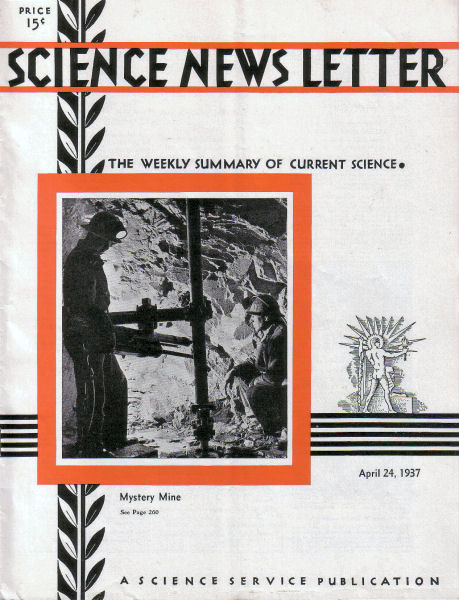From the April 24, 1937, issue

MYSTERY MINE IN BLUE RIDGE REVEALED AS U.S. TEST TUNNEL
Inhabitants of the Virginia town of Bluemont, neighboring farmers, and hill dwellers on the nearby Blue Ridge mountain range have a new mystery to supplant a local murder of some months back. They have been watching strange, out-of-state automobiles and trucks with little-seen government license plates take men and machines into the gravel ridge road that meanders some 5 miles off the main highway and finally reaches Mt. Weather.
These men and their equipment, they know, are for a mine that has been pushed by drilling and blasting through the hard Blue Ridge rock all winter. The local mystery comes in the supposed purpose of the mine; a purpose that in local rumor circles runs all the way from gold mining to the search for some nameless blue-green mineral highly useful for Navy battleships in a way which no one will venture to explain.
On the trail of this Blue Ridge mine mystery, Science Service photographer Fremont Davis and the writer bounced over the twisting ridge road until the U.S. Weather Bureau’s abandoned kite station at Mt. Weather was reached. Still no mine. The caretaker, however, pointed to a still more tortuous road carved through rock and between giant trees on a timbered ridge. Fifty feet down that road, we stopped and backed up in haste to a safe place and went ahead on foot. Finally, down the slope perhaps a quarter mile, we came to the local “mystery” mine.
From deep under our feet we could hear a pneumatic drill battering the hard rock. The exhaust of the motor-driven air compressor was the only other sound in the quiet mountains. The mine, we knew, was the test adit of the U.S. Bureau of Mines, so we searched out the genial resident engineer, Wing G. Agnew.
“Why was the mine? Where was it going? What for? How deep was the tunnel into the mountainside?” The questions poured out as Mr. Agnew grinned and settled back with his cigar in his old farmhouse office.
“Pick yourself one of these ‘hard’ miner’s hats and come on down into the adit,” replied Mr. Agnew. Adit, it should be explained for those who are neither miners nor crossword puzzle fans, is a nearly horizontal entrance to a mine open only at one end, whereas a tunnel has both ends open.
The mine, he explained as we walked down the hillside to the entrance, is truly a test mine where the Bureau of Mines can have command of all controllable conditions in experiments on the efficiency of drill bits, dust production and its relation to the silicosis problem, the efficiency of different kinds of dynamite and blasting agents, mine ventilation, and other problems.
MAJOR FORWARD STEP MADE TOWARD CHLOROPHYLL SYNTHESIS
A major forward step toward the chemical synthesis of chlorophyll, the green coloring matter of plant leaves upon which depends nearly all life on Earth, was disclosed to the Chapel Hill meeting of the American Chemical Society.
About 70 compounds closely related to chlorophyll have been prepared, and some of them have strange and powerful physiological properties. One compound, for example, was injected into rats in small amounts of 10 milligrams and virtually bound the animals to a life in darkness in order to live. As long as they remained in the dark they showed no effect. When removed to daylight, they died in a few hours.
Dr. Paul Rothemund of Antioch College, in describing his researches on these chemical relatives of chlorophyll, also told of a German chemist who tried some of the substance on himself with the result that he, too, was bound to a life “after dark.” For 10 months he could not go out into the light without having his face swell up, suffering intense pain, and having patches of his hair fall out.
While none of Prof. Rothemund’s products are identical with those found in nature, he believes that he or someone else will produce eventually a substance indistinguishable from the natural product.







